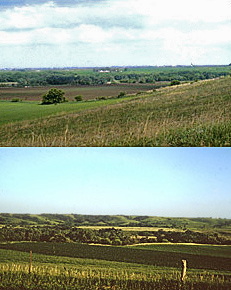Blood Run Site
|
Blood Run Site
|
|
 |
|
| Nearest city | Sioux Falls, South Dakota, Granite, Iowa, and Canton, South Dakota |
|---|---|
| Built | 1300 (possibly built over three millennia) though the site was inhabited regularly for 8500 years in other than mound era dwelling. |
| Architect | Ho-Chunk, Ioway, Otoe, Missouri |
| Architectural style | Civic, Ceremonial, Effigy, and Burial Mounds. Including a 1.25 miles (2.01 km) long snake mound destroyed for railroad fill (1930s). |
| NRHP Reference # | 70000246 |
| Significant dates | |
| Added to NRHP | August 29, 1970 |
| Designated NHL | August 29, 1970 |
Coordinates: 43°28′N 96°35′W / 43.47°N 96.58°W
The Blood Run Site is an archaeological site on the border of the US states of Iowa and South Dakota. The site was essentially populated for 8,500 years, within which earthworks structures were built by the Oneota Culture and occupied descendant tribes such as the Ioway, Otoe, Missouri, and shared with Quapaw and later Kansa, Osage, Omaha (who were both Omaha and Ponca at the time) people. The site was so named on account of the iron-stained soil.
Arikara, Dakota, and Cheyenne were regular traders with the village and Nakota/Dakota and Arikara people also regularly resided there in later years. The site overlaps the Iowa and South Dakota border, near Sioux Falls, South Dakota, between Granite, Iowa, and Harrisburg, South Dakota.
Although declared a National Historic Landmark in 1970, its integrity is endangered by gravel quarrying and looting. The site was substantially looted and areas wholly destroyed by settlers and looters through the late 1930s and by subsequent generations of collectors. A possible snake mound rivaling the Serpent Mound in Ohio was used for railroad fill.
...
Wikipedia
